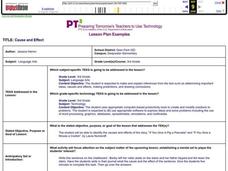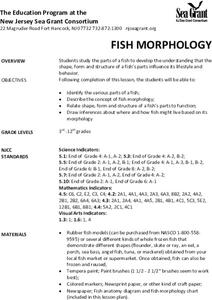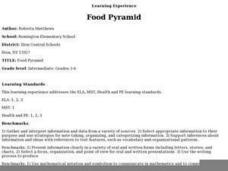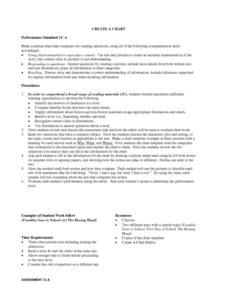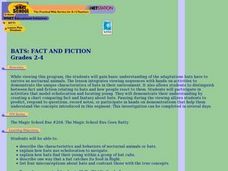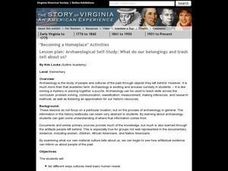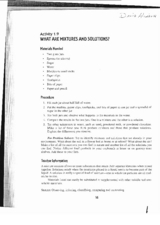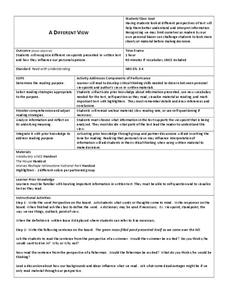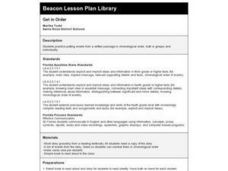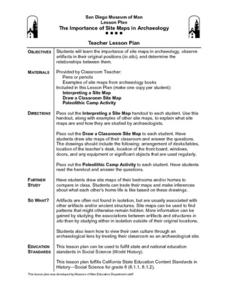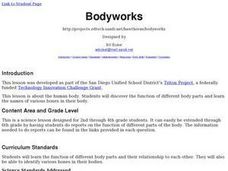Curated OER
Cause and Effect
Third graders identify the causes and effects of the story, "If You Give A Pig a Pancake" and "If You Give a Mouse a Cookie", by Laura Numeroff. They write a cause and effect story using Kidspiration.
Curated OER
Snowy Evening Poetry for ESL (Elementary, Literature)
Learners read Robert Frost's Stopping by the Woods on a Snowy Evening, illustrated by Susan Jeffers (2001). This is a wonderful book with beautiful illustrations that go with each line of the poem.
Curated OER
Alliteration
Students write and illustrate a sentence which names a letter of the alphabet. The sentence should have subject, verb, describing words, and incorporate alliterative techniques.
Curated OER
Saving Money Through Mathematics
Third graders discuss light sources and collect data about energy sources. They compare data and create a multiple line graph showing energy used by light sources for each student in the group. They present their graphs and write a...
Curated OER
Fish Morphology
Students identify the various parts of a fish. They describe the concept of fish morphology and relate shape, form and structure of a fish's parts to function.
Curated OER
Food Pyramid - Daily Diet Diary
Students keep a daily diet diary and discuss the Food Pyramid. They investigate other geometric shapes as a way to display daily food guidelines. In groups, they design a menu for the Food Pyramid Restaurant.
Curated OER
Create a Chart
Students create charts for story elements. They read two selections that share a common theme and discuss the story elements. They create a chart for the characters, plot, and setting and complete it while reading the selections.
Curated OER
Bats: Fact and Fiction
Students describe the characteristics and behaviors of bats. After viewing a video, they explain how bats use echolocation to navigate and how they find their young within a group. They list four misconceptions about the animal and...
Curated OER
Sunlight and Plants
Students design and conduct an experiment to discover the role of direct sunlight on plants during germination and after germination. They plant corn and lima beans in small containers which they place in direct sunlight from a window...
Curated OER
Archaeological Self-Study: What Do Our Belongings and Trash Tell About Us?
Students examine how their belongings and their trash represents who they are. In this archaeology skills lesson, students watch a video titled "Discovering the Past" and then give archaeological techniques a try. Students examine and...
Curated OER
What Are Mixtures And Solutions?
Young scholars explore mixtures and solutions. In this chemistry lesson plan, students will add different ingredients to jars in order to classify them as mixtures or solutions. There is also a nail balancing activity that can be...
Curated OER
A Different View
Readers need to understand how their personal view point may differ or change how they see the view point found in a written text. Third graders read two informational pieces and fill out a graphic organizer to help them differentiate...
Curated OER
Piecing Together the Story of Glenn Cunningham: A Kansas Champion
Learners use primary and secondary sources to conduct research about Glenn Cunningham. In this Glenn Cunningham lesson plan, students tell why he was a hero, and tell facts from what they learned.
Curated OER
The Human Body Systems - Lesson Plan
Learners identify the following organ systems in the human body and state their functions: muscular, skeletal, circulatory, respiratory, digestive.
Curated OER
The Brain and the Sense Organs - Lesson Plan
Students identify the five sense organs and state the uses of the five senses.
Curated OER
Get in Order
Students practice putting events from a written passage in chronological order, both in groups and individually.
Curated OER
The Importance of Site Maps in Archaeology
Students consider the importance of site maps in archeology. They interpret site maps, draw site maps of their classroom and home and then participate in simulated Paleolithic archeological camp activity.
Curated OER
KWL Chart
Students create a KWL chart on a selected nonfiction topic using a variety of strategies. They infer the answers to four questions, identify a purpose for reading, list four or more things about the topic, and list four or more answers...
Curated OER
Why Do We Have Thanksgiving?
Pupils investigate the change in the Thanksgiving holiday over time. They research the Native Americans and Pilgrims to find out how their relationship affected the holiday. They create a PowerPoint presentation using digital cameras...
Curated OER
Documenting Where We Are
Students contribute to discussions and identify how an artist elicits a viewer's response. They use William Henry Jackson's Pawnee Indian Village, photograph and painting. After analyzing this information, students use information gained...
Curated OER
Bodyworks
Students study about the different parts of their body and the names of bones as well. They gain an understanding of the function about the parts. Students follow along as the teacher guides them and points out various parts and their...
Curated OER
Life Cycle of the Butterfly
Students observe and analyze the life cycle and metamorphosis of the Painted Lady Butterfly. They write observation journal entries three times a week and summarize what they observed. Using KidPix computer software they create pictures...
Curated OER
Hero Or Zero?
Learners investigate science and technology by reading a children's book. In this reading comprehension lesson, students read the story Archibald Frisby and discuss the ways we use science and technology in everyday life....
Curated OER
Harriet Tubman: Dancing on the Freedom Trail
Students observe a dance interpretation about Harriet Tubman. For this art/social studies lesson, students explore how their emotions can be expressed through movement and create their own dance or dramatic interpretation.
